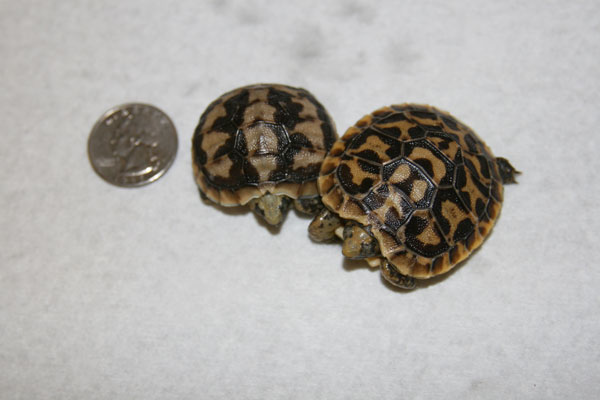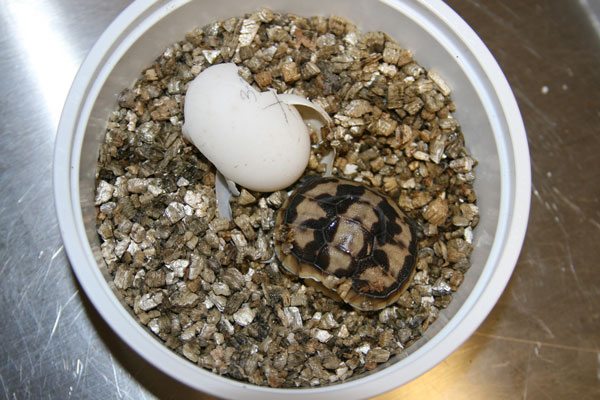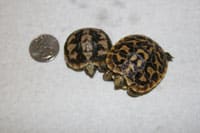Start with a pair of healthy Malacochersus tornieri
Breeding pancake tortoises (Malacochersus tornieri) can be very rewarding in many ways. With their slow reproductive rate and long incubation period, more breeding projects will help provide animals for the pet trade while maintaining genetic diversity in captive populations. At Zoo Med Labs, we have successfully bred pancake tortoises since 2009. This species was a challenge to hatch at first, but we have found a few things that have greatly increased our success rate.

Photo by Ashley Rademacher
Pancake tortoise's hatch after about 150 to 221 days.
First of all, breeding adults should be healthy and in good condition. Egg production takes a lot of energy and calcium, so a proper diet, including supplemental vitamins and calcium, must be provided. When a female needs to lay an egg, she may become very active in searching for a suitable site. Appropriate egg-laying areas must be available for females to deposit their eggs. We use a mixture of 50 percent sand and 50 percent damp coconut fiber in a warm, sheltered area of the enclosure. Eggs found in the slightly damp substrate have had a higher hatch rate than those found in sand or on carpet. If this kind of egg-laying area is available, we find that females prefer to lay their eggs there.

Photo by Ashley Rademacher
The pancake tortoise will lay one, or rarely, two eggs every four to eight weeks.
Pancake tortoises can lay multiple clutches of one, or rarely two, large eggs every four to eight weeks. The egg will usually measure about 2 inches long and 1 inch wide, with a hard, white shell. We mark each egg with the date and an "X" to show orientation when found. Care must be taken not to turn the egg as it is removed. It is then placed in a deli cup and covered about 60 percent with moistened incubation media. We place the egg in an incubator set for 79 degrees Fahrenheit for a six- to 12-week diapause period. After about six weeks, the egg is candled weekly. This means a light is placed up to the egg so you can see an outline of what is inside. When we see development of veins, we turn the temperature up to 80 degrees. Every couple of days, the temperature is turned up one degree until it reaches 86 degrees, where we leave it for the remainder of the incubation period. We maintain humidity in the incubator of 70 to 85 degrees. We have had babies hatch anywhere between 150 and 221 days, but incubation periods as short as 99 days and as long as 137 days have been reported. With this long, unpredictable incubation period, it is important not to give up on eggs.
Pancake tortoise hatchlings usually emerge quickly from the egg – often over night. When the egg has hatched, we remove the hatchling and rinse any incubation media off of it. We then soak it for about 15 minutes in a container of very shallow, warm water. The babies will often extend their necks and put the face in the water and drink. Due to their orientation during development, the plastron will appear to be folded. This will straighten out within 24 to 48 hours. We keep the baby in a container with a damp paper towel on the bottom and place it back in the incubator for a few days until the plastron has straightened out and healed completely. Even as hatchlings, these animals are very good climbers, so they need a container that will keep them from wandering around in the incubator. We take the hatchling out daily and soak it for about 10 to 15 minutes.
After about three to four days in the incubator, the hatchling will be ready for a more permanent setup. Care and setup for hatchlings is very similar to that of adults. We feed them the same diet as adults daily and provide a cuttlefish bone for supplemental calcium.
Ashley Rademacher holds a degree from Moorpark College in Exotic Animal Training and Management with an emphasis on Behavior Management and Wildlife Education, and she currently cares for the reptile collection at Zoo Med Laboratories, Inc. She has kept reptiles for most of her life, and her first pet reptile – an 18-year-old female green iguana – remains with her to this day.


